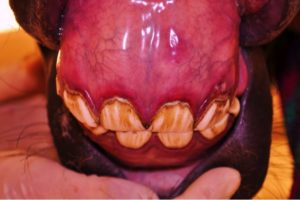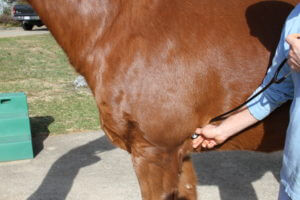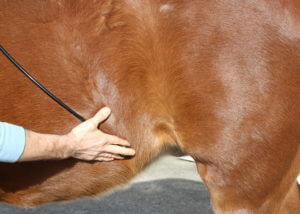A physical examination of the horse is commonly performed by a veterinarian as a part of an annual health checkup, pre-competition type of screening, or during a period of illness. Any horse owner can perform a basic physical examination of their horse with some basic tools and horsemanship. The amount of information that this physical exam can reveal about your horse is incredible, IF you know how to get that information and know what to do with it.
Any horse owner can perform a basic physical examination on their horse. This capability is not limited to a person with a medical license and in many cases, if you can perform a basic exam, you can gain a lot of information regarding your horse’s current health and status.
Why Should You Do a Physical Exam on Your Horse?
There are a few reasons that I think it is important for a horse owner to be able to perform a basic physical exam. These include:
- Basic monitoring of health and fitness
- Monitoring of ongoing health conditions
- Being able to determine health status and severity in case of emergency
All three of these points are important, but the last two are vital and can be time saving for the average veterinarian who may be very busy. If you, as the owner, can assess vital signs in your horse, you may be able to pass on that information in time of need, to your veterinarian and determine whether if an emergency visit is truly needed. Second, in the case of ongoing monitoring, you may be able to report back to your veterinarian with updates, which may minimize farm visits and overall cost with care.
There are 6 basic areas that you should look at with a physical examination in the horse:
- Demeanor or attitude
- Gum color, refill time (CRT)
- Heart rate and rhythm
- Lungs sounds and breathing rate
- Gastrointestinal sounds
- Body Temperature
Demeanor and Attitude in the Horse
The general attitude in the horse is important as this can give us some clues as the severity of the condition, if one is present. In most horses, what you are looking for is the overall head carriage in the standing horse. Is their head up or down? Ears forward and moving, attentive to stimulation? How about their eyes? Are they watching and monitoring their environment? In the veterinary world, we would use the abbreviations BAR or QAR to denote a normal horse, as being ‘bright, alert, and responsive’ or ‘quiet, alert, and responsive’. Any deviation from this should be noted. A horse that has their head down and not paying much attention may indicate a fever, neurological condition, or other depressive type of ailment.
Gum Color and Capillary Refill Time in the Horse
The oral cavity is next on the list of items to evaluate. The normal gum color in the horse is a light, salmon pink. It is also moist to the touch and if you press firmly on the gums with a finger, the color blanches white, then refills to a pink color within 2-3 seconds. That is the capillary refill time and is indicative of adequate blood pressure, circulation, and red blood cell count to perfuse the tissues. These are the normals and any deviation from this is note worthy.

Gum color will vary dependent on certain medical conditions. In cases of anemia, or low red blood cell counts, the gum color will be paler or maybe even white in severe cases. A darker red color is often indicative of blood stagnation, or pooling of blood, as seen in severe cases of infection or endotoxemia. A purple color is indicative of cyanosis, or lack of adequate oxygen binding or perfusion to the tissue, which can be seen with many health ailments.
Gum moisture is reflective of the hydration status of that horse. A normal hydration is noted with moist gums and tongue, while a dehydrated horse will be noted by dry or tacky gums.
Capillary refill time (CRT) often goes hand in hand with the other assessments. CRT indicates blood flow and blood pressure. When it is normal, refill time with be less than 3 seconds. If hydration is impacted or blood flow is altered, this time will be delayed.
The Heart Rate and Rhythm in the Horse
Determining the heart rate and rhythm in the horse is relatively easy to do and can be done using a very basic stethoscope acquired from a local pharmacy or online. The heart rate specifically can help us to determine overall health and fitness, but can also be used to aid in monitoring a painful case of colic or even an infection.

The heart rate in a horse is obtained easily by listening on the left side of the chest, right behind or to the inside of the left elbow. In most horses, the area on this side of the chest is fairly void of hair and can easily be accessed. To determine the heart rate, you simply put the head of the stethoscope into this region, firmly against the chest wall and begin to listen quietly. There are 4 heart sounds associated with the heart beat, but we only generally hear two which are noted by ‘Lub-Dub” type of sound. Listen closely until you are able to hear these sounds, then once you are confident, count how many times the heart beats in a 15 second window of time, then multiply by 4 to get beats per minute. Keep in mind that each ‘lub-dub’ is one heart sound…not two.
The normal heart rate in the horse is around 35-40 beats per minute (bpm). If they are more athletic and fit, often the heart rate will be in that lower range. If the horse just finished exercising or is stressed, the heart rate will be higher. The heart rate will also climb in cases of dehydration or anemia. In horses with pain, such as colic, the heart rate will also be higher and that level of increase can be used to indicate how much pain and potentially, how severe their condition is overall. The average horse with gas colic, rather minor, is about 48 bpm, while a horse with a strangulating obstruction in the intestinal tract will be much higher, around 80-120 bpm.
While you are listening, note the rhythm of the heart beat. It should be steady and regular, like beat..beat…beat. In cases of an arrhythmia, this will be abnormal with extra beats thrown in, sped up intervals of beating with others slow, or in some cases, an absence of a beat overall.
Lung Sounds and Respiratory Rate in the Horse
Lung sounds and the breathing rate are also very easy to acquire in any horse for the most part. Using your stethoscope, you simply listen to both sides of the chest, but keeping in mind that their chest or lung volume is huge, so you need to listen in different sections. I generally do something like high chest, mid chest, then lower chest. Simply put the stethoscope head to the side of the chest and listen. What do you hear? Normally, there should be air moving in and then out, unimpeded. Just remember that they have two sides to their chest!
To get the respiratory rate, you can count how many times they breath in over a 15 second interval and then multiply by 4 to get breathes per minute. The average horse breathes about 12-15 times per minutes, so their breaths are not that frequent. You can also just look at the nares and watch how many times they open/close in a minute’s time. If your veterinarian cannot assess their lung fields adequately, it is common to use a re-breathing bag which forces them to take deeper breaths so the lungs can be more properly assessed.
A horse’s respiratory rate and sounds will vary from condition to condition. An increase in the normal rate, with clear lung fields, may indicate stress, pain, anemia, infection, or other metabolic condition. Alterations in the lung sounds, such as the presence of crackling or wheezing, may be noted with infections such as pneumonia, bronchitis, allergies, or COPD conditions.
Listening for GUT Sounds in the Horse
The next area to monitor is the gut for gastrointestinal sounds. The GI tract in the horse is rather extensive, having both small and large bowel, and a lot of territory to cover. In order to listen to gut sounds, you have to listen in 4 different quadrants, which are the high left flank, low left flank, high right flank, and low right flank. Each quadrant is generally associated with a section of intestinal tract.
- Upper left flank (small intestine)
- Lower left flank (left large colon)
- Upper right flank (small colon)
- Lower right flank (cecum)

When listening, you are simply trying to detect sounds and how frequent those sounds are present. Each wave of sounds is associated with bowel motility or movement. Dependent on the section of bowel that you are detecting, there may be a different type of sound and also frequency. The small intestine tends to produce the most frequent sound. The large colon tends to have a swooshing type of sound and less frequent. The cecum has a pinging type of sound, like water dripping into a metal container, and is less frequent as well. Ideally, you just want to verify that there are ‘sounds’ present in all 4 quadrants at any given time, even if that means you wait a minute to hear them.
Gastrointestinal sounds are indicative of normal bowel motility. In cases of colic, this is vitally important as it can help us to determine which sections of the intestinal tract may be involved. If you fail to hear sounds in the small intestine region, this may imply a problem with that area. Most often, with severe colic cases, the bowel sounds are reduced or absent. In cases of gas, the sounds are slightly increased and you will detect gas pinging around in the different areas. In cases of diarrhea or impending diarrhea, the bowel sounds may be increased dramatically, which indicates an increase in transit time.
Determining Body Temperature in the Horse
The body temperature is last on our list, but is actually the second thing that I personally do on my physical examination. It is relatively easy to perform and just requires a simple glass, mercury based thermometer or elongated digital one.
In order to achieve this task, you have to become up close and personal with your horse. First, shake down the thermometer and coat it with saliva, lubricant, or Vaseline. Then, grasp the base of your horse’s tail, while standing to the side, and lift the tail. This may take some force as some can fight you. Then, gently insert the thermometer into the rectum with one hand, while holding the tail with the other. Hold onto the thermometer a full 2-3 minutes, then remove. DO NOT LET THE THERMOMETER GO! It will be sucked up into the rectum and potentially broken. Not a good situation!
The normal body temperature is 100.8-101.0 degrees F. An elevation above that level can be indicative of post-exercise, stress, or an infectious type of event. A body temperature below that level often indicates user error, meaning you did not do it properly, or a decline in overall body health or health status.
The basic physical examination can be performed by any horse owner on any horse, as long as they are comfortable. The information gained can be invaluable and can be used to monitor their overall health status over time. The more you perform the basic physical exam, the more capable you can become, and the more information you can gather!
Check out our video on the basic physical exam in the horse.
Author: Tom Schell, D.V.M, CVCH, CHN

